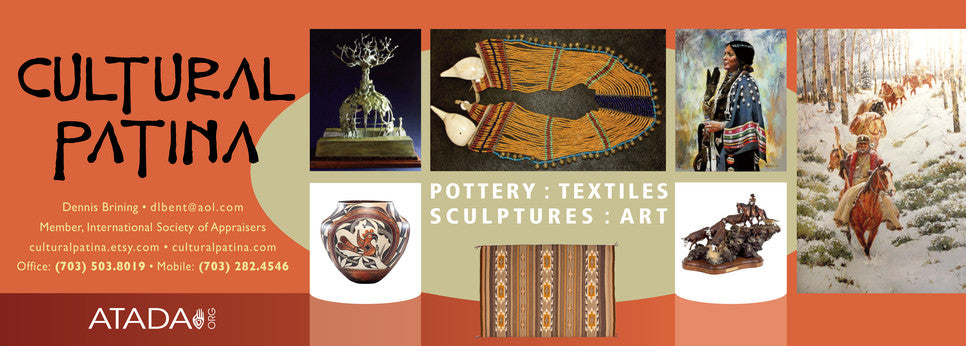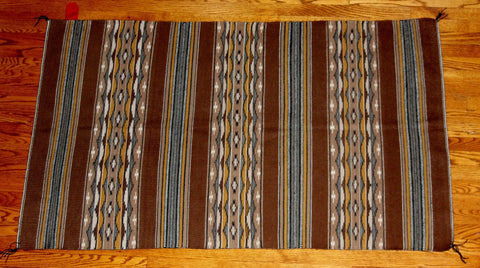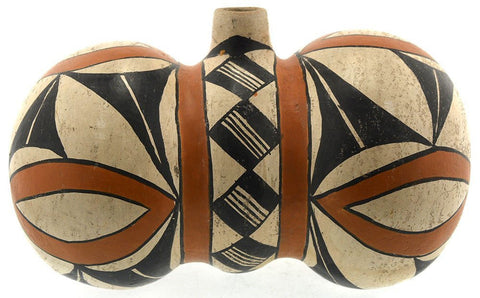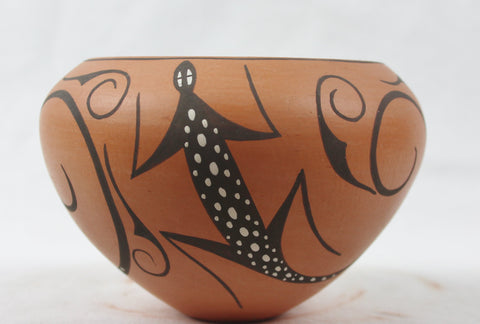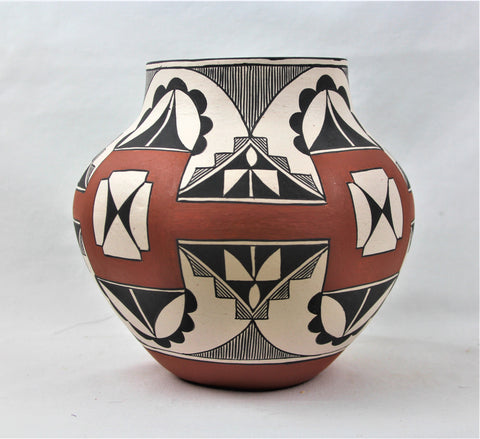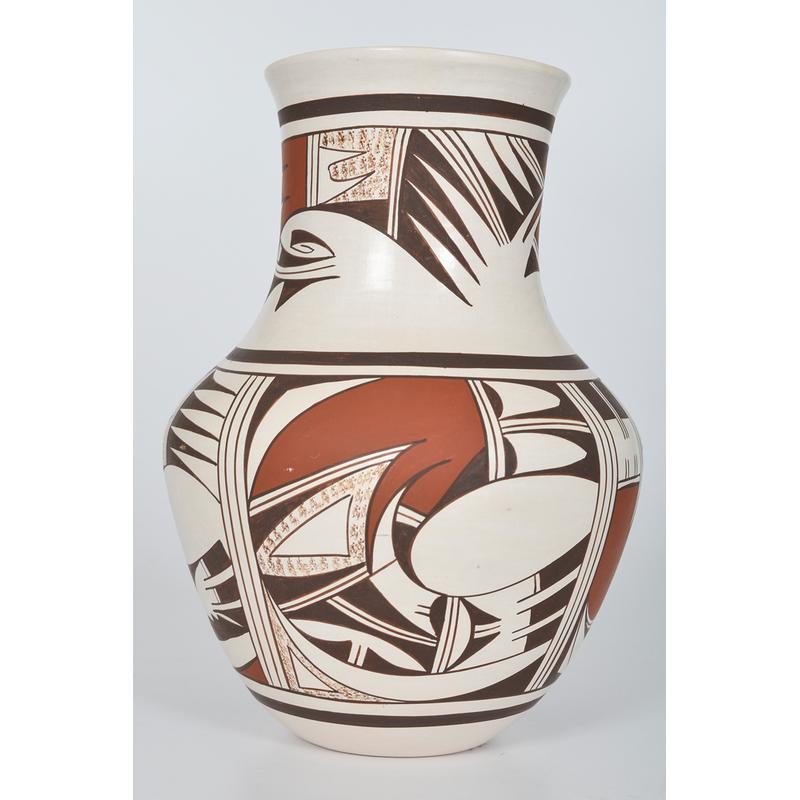
Native American, Hopi Poly Chrome Pottery Vase by Marianne Navasie # 1194 Sold
$ 1,750.00
Native American,
Hopi Poly Chrome Pottery Vase by Marianne Navasie # 1194
Description: # 1194 Native American, Hopi Poly Chrome Pottery Vase by Marianne Navasie. Hopi vase featuring flowing geometric designs, signed on base with frog hallmark of Marianne Navasie (Hopi, 1951-2007), fourth quarter 20th century.
Dimensions: height 9.5 in. x diameter 7 in.
Condition: Excellent for age, has some light surface scuffing.
Hopi-Tewa Reservation
Marianne Navasie is the daughter of famed Joy Navasie, and the grand-daughter of world renowned Paqua Naha, the original frog woman. Marianne was born in 1951, and has been making pottery since she was 18 years old.
Although, Marianne was only three years old when her grandmother died, she does recall her and her mother always working with the clay. Marianne has mastered the white ware look pioneered by Paqua, and carried on by her mother, and now Marianne is continuing with the family tradition.
Marianne stated, “ My Mother always pushed us to stay with traditional hand coiled pottery making methods, and to carry on the frog style.” One look at Marianne’s pottery and it is evident that she has mastered the art which was created by her ancestors.
She gathers all her materials (natural pigments) from within the Hopi Reservation. Marianne cleans, mixes, hand coils, shapes, sands, paints, and fires her pottery, outdoors, with sheep dung.
Marianne signs her pottery with the “Paqua”, (frog) symbol, but does put a tadpole next to it so it indicates her place within her family tree.
Marianne is left handed so her work will move in the opposite direction of her mother‘s.
Awards:
-Santa Fe Indian Market
-New Mexico State Fair
-Gallup Indian Ceremonial 1st place
-Scottsdale Hopi Show
-Flagstaff Hopi Show
Publications:
-Hopi-Tewa Pottery 500 Artist Biographies
-Fourteen Families in Pueblo Pottery
-Southwest Pottery for Anasazi to Zuni
-Collecting Southwestern Indian Arts and Crafts
-Cover of Gallup Ceremonial Brochure (1978)
Source: material-insight.com)
“Pueblo pottery is made using a coiled technique that came into northern Arizona and New Mexico from the south, some 1500 years ago. In the four-corners region of the US, nineteen pueblos and villages have historically produced pottery. Although each of these pueblos use similar traditional methods of coiling, shaping, finishing and firing, the pottery from each is distinctive. Various clays gathered from each pueblo’s local sources produce pottery colors that range from buff to earthy yellows, oranges, and reds, as well as black. Fired pots are sometimes left plain and other times decorated—most frequently with paint and occasionally with appliqué. Painted designs vary from pueblo to pueblo, yet share an ancient iconography based on abstract representations of clouds, rain, feathers, birds, plants, animals and other natural world features.
Tempering materials and paints, also from natural sources, contribute further to the distinctiveness of each pueblo’s pottery. Some paints are derived from plants, others from minerals. Before firing, potters in some pueblos apply a light colored slip to their pottery, which creates a bright background for painted designs or simply a lighter color plain ware vessel. Designs are painted on before firing, traditionally with a brush fashioned from yucca fiber.
Different combinations of paint color, clay color, and slips are characteristic of different pueblos. Among them are black on cream, black on buff, black on red, dark brown and dark red on white (as found in Zuni pottery), matte red on red, and polychrome—a number of natural colors on one vessel (most typically associated with Hopi). Pueblo potters also produce undecorated polished black ware, black on black ware, and carved red and carved black wares.
Making pueblo pottery is a time-consuming effort that includes gathering and preparing the clay, building and shaping the coiled pot, gathering plants to make the colored dyes, constructing yucca brushes, and, often, making a clay slip. While some Pueblo artists fire in kilns, most still fire in the traditional way in an outside fire pit, covering their vessels with large potsherds and dried sheep dung. Pottery is left to bake for many hours, producing a high-fired result.
Today, Pueblo potters continue to honor this centuries-old tradition of hand-coiled pottery production, yet value the need for contemporary artistic expression as well. They continue to improve their style, methods and designs, often combining traditional and contemporary techniques to create striking new works of art.” (Source: Museum of Northern Arizona)
Hopi Poly Chrome Pottery Vase by Marianne Navasie # 1194
Description: # 1194 Native American, Hopi Poly Chrome Pottery Vase by Marianne Navasie. Hopi vase featuring flowing geometric designs, signed on base with frog hallmark of Marianne Navasie (Hopi, 1951-2007), fourth quarter 20th century.
Dimensions: height 9.5 in. x diameter 7 in.
Condition: Excellent for age, has some light surface scuffing.
Hopi-Tewa Reservation
Marianne Navasie is the daughter of famed Joy Navasie, and the grand-daughter of world renowned Paqua Naha, the original frog woman. Marianne was born in 1951, and has been making pottery since she was 18 years old.
Although, Marianne was only three years old when her grandmother died, she does recall her and her mother always working with the clay. Marianne has mastered the white ware look pioneered by Paqua, and carried on by her mother, and now Marianne is continuing with the family tradition.
Marianne stated, “ My Mother always pushed us to stay with traditional hand coiled pottery making methods, and to carry on the frog style.” One look at Marianne’s pottery and it is evident that she has mastered the art which was created by her ancestors.
She gathers all her materials (natural pigments) from within the Hopi Reservation. Marianne cleans, mixes, hand coils, shapes, sands, paints, and fires her pottery, outdoors, with sheep dung.
Marianne signs her pottery with the “Paqua”, (frog) symbol, but does put a tadpole next to it so it indicates her place within her family tree.
Marianne is left handed so her work will move in the opposite direction of her mother‘s.
Awards:
-Santa Fe Indian Market
-New Mexico State Fair
-Gallup Indian Ceremonial 1st place
-Scottsdale Hopi Show
-Flagstaff Hopi Show
Publications:
-Hopi-Tewa Pottery 500 Artist Biographies
-Fourteen Families in Pueblo Pottery
-Southwest Pottery for Anasazi to Zuni
-Collecting Southwestern Indian Arts and Crafts
-Cover of Gallup Ceremonial Brochure (1978)
Source: material-insight.com)
“Pueblo pottery is made using a coiled technique that came into northern Arizona and New Mexico from the south, some 1500 years ago. In the four-corners region of the US, nineteen pueblos and villages have historically produced pottery. Although each of these pueblos use similar traditional methods of coiling, shaping, finishing and firing, the pottery from each is distinctive. Various clays gathered from each pueblo’s local sources produce pottery colors that range from buff to earthy yellows, oranges, and reds, as well as black. Fired pots are sometimes left plain and other times decorated—most frequently with paint and occasionally with appliqué. Painted designs vary from pueblo to pueblo, yet share an ancient iconography based on abstract representations of clouds, rain, feathers, birds, plants, animals and other natural world features.
Tempering materials and paints, also from natural sources, contribute further to the distinctiveness of each pueblo’s pottery. Some paints are derived from plants, others from minerals. Before firing, potters in some pueblos apply a light colored slip to their pottery, which creates a bright background for painted designs or simply a lighter color plain ware vessel. Designs are painted on before firing, traditionally with a brush fashioned from yucca fiber.
Different combinations of paint color, clay color, and slips are characteristic of different pueblos. Among them are black on cream, black on buff, black on red, dark brown and dark red on white (as found in Zuni pottery), matte red on red, and polychrome—a number of natural colors on one vessel (most typically associated with Hopi). Pueblo potters also produce undecorated polished black ware, black on black ware, and carved red and carved black wares.
Making pueblo pottery is a time-consuming effort that includes gathering and preparing the clay, building and shaping the coiled pot, gathering plants to make the colored dyes, constructing yucca brushes, and, often, making a clay slip. While some Pueblo artists fire in kilns, most still fire in the traditional way in an outside fire pit, covering their vessels with large potsherds and dried sheep dung. Pottery is left to bake for many hours, producing a high-fired result.
Today, Pueblo potters continue to honor this centuries-old tradition of hand-coiled pottery production, yet value the need for contemporary artistic expression as well. They continue to improve their style, methods and designs, often combining traditional and contemporary techniques to create striking new works of art.” (Source: Museum of Northern Arizona)
Related Products
Sold out
Sold out
Sold out
